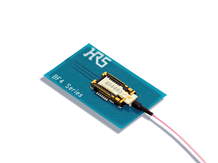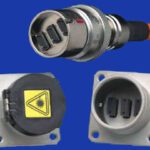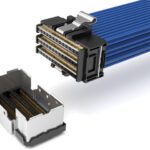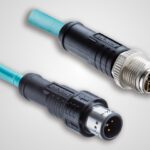Communication Cabling on the Factory Floor
Industrial and robotic service equipment operates in conditions and applications as varied as the robots themselves. If you want reliable robots, select reliable cable. Here’s how to do that.
Communication Cabling on the Factory Floor
 Robots in factory automation applications are often exposed to harsh environments and require highly reliable and carefully optimized connectors that meet high-speed transmission and small size requirements. In addition to connectivity solutions, the type of cabling used to connect industrial equipment plays a large role in enabling the higher speed systems to also meet reliability standards.
Robots in factory automation applications are often exposed to harsh environments and require highly reliable and carefully optimized connectors that meet high-speed transmission and small size requirements. In addition to connectivity solutions, the type of cabling used to connect industrial equipment plays a large role in enabling the higher speed systems to also meet reliability standards.
Standard copper-based systems meet the needs of many industrial systems, but the importance of sensing, monitoring, and reporting has made high-speed data transmission a necessity on the factory floor. Higher-bandwidth communication systems enable equipment to send/receive more data, and via sophisticated software systems, monitor, analyze, and react to this information accordingly to increase productivity. Highly flexible active optical systems are now being used to replace copper systems to deliver long-distance, high-speed, and high-quality signal transmissions that meet the demands of industrial automation equipment on the factory floor.
The evolution of communication systems on the factory floor starts with basic copper-based transmission systems, which are an excellent medium for lower-speed, shorter-distance transmission. For example, the RS-232 standard 9600bps port will support 15 meters of shielded cable. However, as data rate requirements increase, transmission distance capabilities decrease, and vice versa. Although RS-232 can now deliver higher bandwidths – escalating from 10 kilobits to 100 kilobits and now one megabit – transmission distance is significantly reduced. In addition, copper wire at higher speeds can experience problematic voltage drops, EMI, and channel noise. As a result, basic copper systems cannot support the high-speed transmission over the longer distances required on many factory floors.
Differential signaling was developed to address some of these issues with the single-ended RS-232. The differential driven RS-422 and RS-485 can reach distances of more than 1200 meters at a data rate of 10Mb/s.
The implementation of copper Ethernet protocols enables 10/100/1000baseT bandwidth over a distance of up to 100m. Cat 6 Ethernet cable was developed to implement this protocol, but users are limited to 1Gb/s and around 100m. When used for 10GbaseT, Cat 6 can offer a transmission distance of about 55m.
Because of its smaller size and lower weight, optical cable is now a preferred option to achieve high bandwidth and long transmission distances in many industrial applications. Optical cable has come a long way since its first inception on the factory floor. First-generation fiber optic cable installations were difficult to handle and could easily break. In addition, performance problems occurred when the connectors of the fiber optic cable were not fit properly. The technology has since evolved to become more flexible, durable, and easier to work with.
Another problem with the first-gen optics was the very high costs. Small form factor pluggable (SFP) is a specification for optical transceivers. An SFP design allows designers to convert electrical signals into optical signals in a standardized envelope and drive the optical signal across greater distances using either a multimode or single-mode cable. Built on a single transmit/receive channel platform, SFP devices are designed for use with small form factor (SFF) connectors and offer high-speed data transmission of 10Gb/s in a small package. Designers have expanded the technology to include multiple transmit/receive devices into a single envelope, which greatly increases the bandwidth of the SFP system as well as the power requirements. The power required for a single SFP channel to convert an electrical signal into an optical signal in an SFP system is upwards of 3W. When a system uses 10, 12, or even 24 SFP devices packaged side-by-side or on a panel, the power requirements, and thus heat generation is exponentially increased. And since heat is a primary factor in the degradation of electronics, this high power requirement presents a significant design challenge.
Active fiber optic transmission technology offers a more flexible solution for applications that require high-speed transmissions in a single multimode line. Active fiber optic systems can support high data rates in a single line with only 40mW of electrical power. The small, space-saving embedded active optical system achieves a lower power rating via its unique design. The manufacturing of these systems is facilitated by separation of the soldered connector from the transmit/receive modules. This enables the optical device with built-in E/O and O/E converters to be plugged onto the board.
Active optical systems convert balanced, high-speed, differential electrical signal on one end of a PCB into MM optical signal for transmission down a very thin, flexible FO cable, and then converts it back into an electrical signal on the other end. Designed with an ultra low profile, space-saving receptacle, these active optical fiber plug assemblies feature the built-in E/O on the Tx end and an O/E on the Rx end. This user-friendly optical interconnect will accommodate up to 6.25Gb/s signals and provide long-distance transmission up to 300m, along with all the benefits of fiber optic signaling including signal quality, noise immunity, and low noise generation. While designed for video broadcast, factory automation is an ideal solution for applications that require long reach, high-speed, and limited wiring space. As a fiber transmission device, the system provides excellent electrical isolation as well. Active optical systems, such as Hirose’s BF4 Series, enable design engineers to overcome a number of challenges including ease of use, low power, low noise, EMI, and high-speed transmission over long distances.
Today, active optical systems are more commonly being utilized to meet factory floor communication needs. The usefulness of copper systems is by no means obsolete, especially with the continuing evolution and adoption of the copper Ethernet protocols. However, to reach the distances, transmission speed, and overall performance specifications required for sensor-centric industrial equipment, active optical systems are the preferred choice.
Recently published:
[related_posts limit=”10″]






